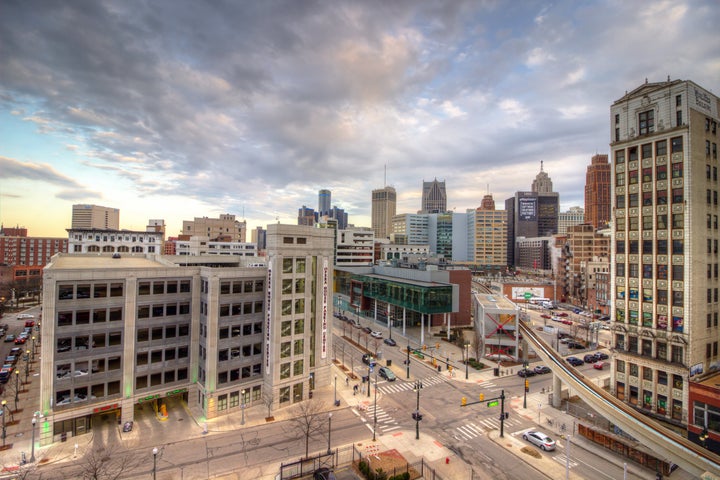
I have not lived in Detroit for 13 years. But I was born and raised on the west side of the city, and nearly all of my immediate family resides in the city or metro Detroit. My father still lives in the house in which I grew up, off of West 8 Mile and Livernois.
Since leaving, I’ve mostly visited the city in intervals measured by quarters of a year. That infrequency has allowed for changes in parts the city that tend to catch me off guard when I return – a strip mall on 8 Mile here, a dramatically transformed Midtown neighborhood there.
Sadly, however, many of my visits remind me that much of the city looks as it did, or worse, than when I was a child in the 1980s and 1990s. Though I find myself defending the city against the media’s seemingly relentless depiction of Detroit as a post-apocalyptic wasteland, it still upsets me to see that the city that had more than a million residents when I was a child is an emptier, weaker version of itself, with a bit over 670,000 residents and falling.
The film “Detroit” (opening Aug. 4), despite being largely shot in and around Boston, did a very good job of capturing the physical authenticity of the 12th Street and Clairmount area – the nexus of the real-life July 1967 rebellion around which the film is based. The four-day incident remains one of the worst examples of civil unrest in the city’s history and resulted in irreparable damage to business on 12th Street, which is now Rosa Parks Drive.
The problem is that the rebellion occurred a full 50 years from today (July 25), and the area still looks like it happened yesterday. Watching scenes from “Detroit” – which includes historical footage and photos from throughout the city at the time – served as a sobering reminder that, while a lot has changed in Detroit in the last half century, not nearly enough has.
I’ve endured talk of Detroit’s economic “revival” since I was a little boy and the “white flight” exodus of white people moving to the suburbs was nearing completion. With many politicians and businessmen throwing their hats in the ring, such discussions bordered on bromidic. It’s not until the last decade or so that investors and companies realized the fertility of Detroit (read: dirt-cheap property), which has resulted in hundreds of millions in capital being funneled into the city. Industrious non-native white people realized that they could swoop in during the Great Recession and buy up beautiful three-story Tudor-style homes for $20,000, rehabilitate them and create their own neighborhoods.
All of this has resulted in enclaves of Detroit that are now attractive to educated, working white Millennials. In the Cass Corridor, where I passed needle trucks and prostitutes to attend public school for 10 years, 20-something people in yoga pants now breeze up and down the sidewalks. Trendy gastropub restaurants exist on blocks where natives knew better to keep away from after certain hours. Downtown condos fetch risibly high prices that rival those of Chicago, my adopted city.
But in a city of 143 square miles, the vast majority of its denizens still hurt. I can get the best slice of pizza I’ve ever had from a Midtown restaurant, but when I drive through the neighborhood in which my mother grew up near Grand River and Wyoming after sunset, I see blocks of darkness that serve as a specter of residents who fled the city and city services that all but neglect neighborhoods like these.
Everything that my family has been debating for years at holiday gatherings about what needs to happen with the city seems to finally be on its way, but if it all plays out like the textbook gentrification that has hit cities like Chicago, many of the black families that have been in Detroit for generations stand to be unaffected by the change in a best-cast scenario. In the worst case, they might suffer from it.
Though we native Detroiters will have strong opinions about the film’s depiction of the city, the biggest talking point of the “Detroit” will inevitably surround its unflinching depiction of police brutality. Despite the Detroit Police Department having its most diverse police force ever, as the film’s chief antagonist Will Poulter has reminded reporters during the film’s press tour, “Detroit” comes following a years-long, seemingly interminable string of civilian deaths at the hands of police – mostly with white cops killing black people – and the officers’ inevitable, outrage-inducing acquittals. The film depicts an officer being sent back on duty while under investigation for killing a young black kid – not such a stretch in 2017.
Of course, “Detroit” contains bits of nostalgia that Detroiters of any generation can appreciate: a character in an early scene who assists a kid wounded by the police reminded me of my late grandmother and the many matriarchs who would keep an eye out on kids playing on the sidewalk as they gossiped on the porch on a summer day. Factory workers in the film serve as a reminder of the literal and metaphorical engines that built Detroit before the machines and computers took center stage. And, of course, there’s our nonpareil Motown music scene, depicted via music from artists like Martha and The Vandellas and The Dramatics. (The latter are surprisingly essential to the film’s plot.)
Regardless of its physical and economic state, the city of Detroit remains a wonderful town with its own distinct character and culture; we tend to find each other wherever we go throughout the country and remain fiercely loyal to the city, especially against trash-talking outsiders and unbalanced media depictions – I felt an innate desire to defend the city to a shuttle bus full of out-of-town journalists looking out the windows as we rolled eastbound on 8 Mile to watch a screener of the film. But I also recognize that the city and its denizens still require a great deal; watching “Detroit” simply reinforced that for me.
As I wrote this piece in a hotel restaurant, one of the “Detroit” actors came up and asked me if I have an anodyne for the Detroiters that stand not to benefit, or to lose, from the city’s revitalization. He said he did not; I told him I didn’t either.
